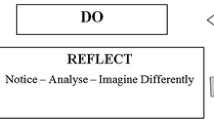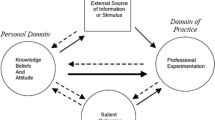Abstract
This study describes the Reflection Connection Cycle professional development designed to support teachers’ use and appreciation of students’ out-of-school practices related to school mathematics. The year-long program incorporated group lesson design, readings, and video analysis for 14 elementary school (ages 5–12) teachers. Analysis of lesson development, written reflections, and analysis of teacher talk revealed important patterns related to the difficulty in writing lessons that built on students’ informal understandings. While initial lessons focused solely on the context of practices like gardening and sports, subsequent lessons show a greater concern for the mathematics in which children were engaged within a practice. A Multi-approach Engagement Framework is presented both as a tool to support further professional development efforts and as a means to describe stability and change in teachers’ efforts to connect in-school and out-of-school mathematical understandings.




Similar content being viewed by others
References
Ball, D. L. (1996). Teacher learning and the mathematics reforms: What we think we know and what we need to learn. Phi Delta Kappa, 77, 500–508.
Ball, D. L., & Cohen, D. K. (1999). Developing practice, developing practitioners: Toward a practice-based theory of professional education. In L. Darling-Hammond & G. Sykes (Eds.), Teaching as the learning profession: Handbook of policy and practice (pp. 3–32). San Francisco: Jossey-Bass.
Borko, H., Jacobs, J., Eiteljorg, E., & Pittman, M. E. (2008). Video as a tool for fostering productive discussions in mathematics professional development. Teaching and Teacher Education, 24, 417–436.
Bottge, B. A. (2001). Reconceptualizing math problem solving for low-achieving students. Remedial and Special Education, 22, 102–112.
Brenner, M. E. (1998). Meaning and money. Educational Studies in Mathematics, 36, 123–155.
Brophy, J. (Ed.). (2004). Advances in research on teaching: Vol. 1. Using video in teacher education. Oxford, UK: Elsevier.
Carpenter, T. P., & Fennema, E. (1992). Cognitively guided instruction: Building on the knowledge of students and teachers. International Journal of Educational Research, 17, 457–470.
Carpenter, T. P., Fennema, E., & Franke, M. L. (1996). Cognitively guided instruction: A knowledge base for reform in primary mathematics instruction. The Elementary School Journal, 97(1), 3–20.
Carpenter, T. P., Fennema, E., Peterson, P. L., Chiang, C. P., & Loef, M. (1989). Using knowledge of children’s mathematics thinking in classroom teaching: An experimental study. American Educational Research Journal, 26(4), 499–531.
Chamberlin, M. T. (2005). Teacher discussions of students’ thinking: Meeting the challenge of attending to students’ thinking. Journal of Mathematics Teacher Education, 8(2), 141–170.
Cole, M. (1996). Cultural psychology: A once and future discipline. Cambridge, MA: Belknap/Harvard University Press.
Cole, M., & Bruner, J. S. (1971). Cultural differences and inferences about psychological processes. American Psychologist, 26, 867–876.
Diversity in Mathematics Education Center for Learning, Teaching. (2007). Culture, race, power, and mathematics education. In F. Lester (Ed.), Second handbook of research on mathematics teaching and learning (pp. 405–434). Charlotte, NC: Information Age Publishing.
Foote, M. Q. (2010). The power of one: Teachers examine their mathematics teaching practice by studying a single child. In M. Q. Foote (Ed.), Mathematics teaching and learning K-12: Equity and professional development (pp. 41–58). New York: Palgrave.
Fuson, K. (1992). Research on whole number addition and subtraction. In D. Grouws (Ed.), Handbook of research on mathematics teaching and learning (pp. 243–275). New York: Macmillan.
Gearhart, M., & Wolf, S. A. (1997). Issues in portfolio assessment: Assessing writing processes from their products. Educational Assessment, 4, 265–296.
Gonzalez, N., Andrade, R., Civil, M., & Moll, L. (2001). Bridging funds of distributed knowledge: Creating zones of practices in mathematics. Journal of Education for Students Placed at Risk, 6(1), 115–132.
Guberman, S. R. (1996). The development of everyday mathematics in Brazilian children with limited formal education. Child Development, 67, 1609–1623.
Gutstein, E., & Peterson, B. (Eds.). (2005). Rethinking mathematics: Teaching social justice by the numbers. Milwaukee, WI: Rethinking Schools.
Hawley, W. D., & Valli, L. (1999). The essentials of effective professional development: A new consensus. In L. Darling-Hammond & G. Sykes (Eds.), Teaching as the learning profession: Handbook of policy and practice (pp. 127–150). San Francisco, CA: Jossey-Bass.
Hiebert, J., & Wearne, D. (1996). Instruction, understanding, and skill in multidigit addition and subtraction. Cognition and Instruction, 14, 251–283.
Kazemi, E., & Franke, M. L. (2004). Teacher learning in mathematics: Using student work to promote collective inquiry. Journal of Mathematics Teacher Education, 7, 203–235.
Labov, W. (1972). Language in the inner city: Studies in the Black English vernacular. Philadelphia: University of Pennsylvania Press.
Ladson-Billings, G. (1995). Making mathematics meaningful in a multicultural context. In W. G. Secada, E. Fennema, & L. B. Adajian (Eds.), New directions for equity in mathematics education (pp. 126–145). New York: Cambridge University Press.
Lampert, M., & Ball, D. (1990). Using hypermedia technology to support a new pedagogy of teacher education. National Center for Research on Teacher Education, Michigan State University.
Lave, J., & Wenger, E. (1991). Situated learning: Legitimate peripheral participation. Cambridge, UK: Cambridge University Press.
Lipka, J. (1994). Culturally negotiated schooling: Toward a Yup’ik mathematics. Journal of American Indian Education, 33(3), 14–30.
Little, J. W. (2002). Locating learning in teachers’ professional community: Opening up problems of analysis in records of everyday work. Teaching and Teacher Education, 18(8), 917–946.
McIntosh, A., Reys, B. J., & Reys, R. E. (1992). A proposed framework for examining basic number sense. For the Learning of Mathematics, 12, 2–8.
Moschkovich, J. (2002). An introduction to examining everyday and academic mathematical practices. In M. Brenner, & J. Moschkovich (Eds.), Everyday and academic mathematics in the classroom. Journal for Research in Mathematics Education, Monograph Number 11, 1–11.
Moses, R. P., & Cobb, C. E. (2001). Radical equations: Math literacy and civil rights. Boston: Beacon Press.
National Council of Teachers of Mathematics. (2000). Principles and standards for school mathematics. Reston, VA: NCTM.
National Research Council. (1989). Everybody counts: A report to the nation on the future of mathematics education. Washington, DC: National Academic Press.
Nunes, T., Schliemann, A. D., & Carraher, D. W. (1993). Mathematics in the streets and in schools. Cambridge, U.K: Cambridge University Press.
Putnam, R. T., & Borko, H. (1997). Teacher learning: Implications of new views of cognition. In B. J. Biddle, T. L. Good, & I. F. Goodson (Eds.), International handbook of teachers and teaching (2nd ed., pp. 1223–1296). Dordrecht, The Netherlands: Kluwer.
Putnam, R. T., & Borko, H. (2000). What do new views of knowledge and thinking have to say about research on teacher learning? Educational Researcher, 29(1), 4–15.
Reys, R. E., & Yang, D. C. (1998). Relationship between computational performance and number sense among sixth and eighth grade students in Taiwan. Journal for Research in Mathematics Education, 2(2), 225–227.
Rogoff, B. (2003). The cultural nature of human development. New York: Oxford University Press.
Saxe, G. B. (1988). The mathematics of child street vendors. Child Development, 59, 1415–1425.
Saxe, G. B. (1991). Culture and cognitive development: Studies in mathematical development. Hillsdale NJ: Lawrence Erlbaum Associates.
Sherin, M. G., & Han, S. (2004). Teacher learning in the context of a video club. Teaching and Teacher Education, 20, 163–183.
Smith, M. S. (2002). Practice-based professional development for mathematics teachers. Reston, VA: National Council of Teachers of Mathematics.
Taylor, E. V. (2000, April). Multi-unit conceptual understanding in low-income African-American first and second grade students: The influence of currency knowledge. Paper presented at the annual meeting of the American Educational Research Association, New Orleans, LA.
Taylor, E. V. (2009). Purchasing practice of low-income students: The relation to mathematical development. Journal of the Learning Sciences, 18(3), 370–415.
Taylor, E. V., & Kitchen, R. (2008). Doctoral programs in mathematics education: Diversity and equity. In R. E. Reys & J. A. Dossey (Eds.), U. S. Doctorates in mathematics education: Developing stewards of the discipline (Vol. 15, pp. 111–116). Washington, DC: American Mathematical Society.
Watanabe, T. (1996). Ben’s understanding of one-half. Teaching Children Mathematics, 2(8), 460–464.
Wilson, S. M., & Berne, J. (1999). Teacher learning and the acquisition of professional knowledge: An examination of research on contemporary professional development. In A. Iran-Nejad & P. D. Pearson (Eds.), Review of research and education, 24 (pp. 173–209). Washington, DC: American Educational Research Association.
Zeichner, K., & Liston, D. (1990). Traditions of reform in US teacher education. Journal of Teacher Education, 41, 3–20.
Acknowledgments
The author would like to thank Anita Wager, the co-facilitator of the professional development program, and the assistance of student researchers Ruben Navarro, Lilia Vreeland, and Bradford Whitman. Miriam Sherin provided valuable feedback to an earlier draft of this manuscript. The material in this paper is based in part on work supported by the National Science Foundation under Grant No. ESI-0119732 to the Diversity in Mathematics Education Center for Learning and Teaching (DiME). Any opinions, findings, and conclusions or recommendations expressed in this material are those of the author and do not necessarily reflect the position, policy, or endorsement of the National Science Foundation.
Author information
Authors and Affiliations
Corresponding author
Appendix
Appendix
Bibliography of required readings included in the analysis
-
Bottge, B. A. (2001). Reconceptualizing math problem solving for low-achieving students. Remedial and Special Education, 22, 102–112
-
Brenner, M. E. (1998). Meaning and money. Educational Studies in Mathematics, 36, 123–155.
-
Gonzalez, N., Andrade, R., Civil, M., & Moll, L. (2001). Bridging funds of distributed knowledge: Creating zones of practices in mathematics, Journal of Education for Students Placed at Risk, 6(1), 115–132.
-
Griffin, S. (2004). Teaching number sense. Educational Leadership, 61(6), 39–42.
-
Hiebert, J., Carpenter, T. P., Fennema, E., Fuson, K. C., Wearne, D., Murray, H., Human, P., & Olivier, A. (1997). Making sense: Teaching and learning mathematics with understanding (pp. 129–159). Portsmouth, NH: Heinemann.
-
Moses, R. (2001). Radical equations: Math literacy and Civil Rights. Boston: Beacon Press.
-
Moschkovich, J. (2002). An Introduction to examining everyday and academic mathematical practices. In M. Brenner, & J. Moschkovich (Eds.), Everyday and academic mathematics in the classroom. Journal for Research in Mathematics Education, Monograph Number 11, 1–11.
-
Taylor, E. V. (2000, April). Multi-unit conceptual understanding in low-income African-American first and second grade students: The influence of currency knowledge. Paper presented at the annual meeting of the American Educational Research Association, New Orleans, LA.
-
Watanabe, T. (1996). Ben’s understanding of one-half. Teaching Children Mathematics, 2(8), 460–464.
Rights and permissions
About this article
Cite this article
Taylor, E.V. Supporting children’s mathematical understanding: professional development focused on out-of-school practices. J Math Teacher Educ 15, 271–291 (2012). https://doi.org/10.1007/s10857-011-9187-7
Published:
Issue Date:
DOI: https://doi.org/10.1007/s10857-011-9187-7




